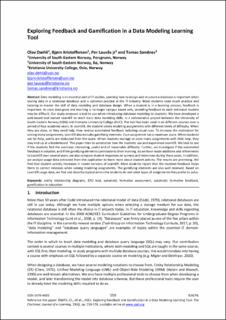| dc.description.abstract | Data modeling is an essential part of IT studies. Learning how to design and structure a database is important when storing data in a relational database and is common practice in the IT industry. Most students need much practice and tutoring to master the skill of data modeling and database design. When a student is in a learning process, feedback is important. As class sizes grow and teaching is no longer campus based only, providing feedback to each individual student may be difficult. Our study proposes a tool to use when introducing database modeling to students. We have developed a web-based tool named LearnER to teach basic data modeling skills, in a collaborative project between the University of South-Eastern Norway (USN) and Kristiania University College (KUC). The tool has been used in six different courses over a period of four academic years. In LearnER, the student solves modeling assignments with different levels of difficulty. When they are done, or they need help, they receive automated feedback including visual cues. To increase the motivation for solving many assignments, LearnER also includes gamifying elements. Each assignment has a maximum score. When students ask for help, points are deducted from the score. When students manage to solve many assignments with little help, they may end up at a leaderboard. This paper tries to summarize how the students use and experience LearnER. We look to see if the students find the exercises interesting, useful and of reasonable difficulty. Further, we investigate if the automated feedback is valuable, and if the gamifying elements contribute to their learning. As we have made additions and refinements to LearnER over several years, we also compare student responses on surveys and interviews during these years. In addition, we analyze usage data extracted from the application to learn more about student activity. The results are promising. We find that student activity increases in newer versions of LearnER. Most students report that the received feedback helps them to correct mistakes when solving modeling assignments. The gamifying elements are also well received. Based on LearnER usage data, we find and describe typical errors the students do and what types of assignments they prefer to solve. | en_US |

